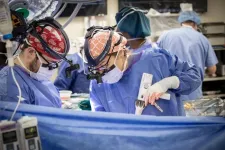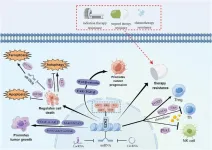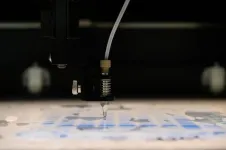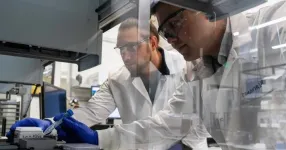(Press-News.org) Surgeons and teams with Vanderbilt Lung Transplant performed 99 lung transplants in 2024, the most ever in one year. Two of the procedures involved combined organ transplants.
For the second calendar year in a row, Vanderbilt Lung Transplant has the busiest program in the Southeast and leads the nation in innovation in organ preservation and regeneration.
The Vanderbilt Transplant Center is now home to the nation’s eighth largest lung transplant program by volume, and is among the best in long-term outcomes, demonstrating the success of the interdisciplinary team in caring for these complex patients.
This significant achievement reflects the concerted effort of a multidisciplinary collaboration by the Departments of Thoracic Surgery, Medicine and Anesthesiology and Critical Care.
“It is a challenge to achieve both significant growth and maintain high-quality outcomes, which is something that requires a team effort and deliberate planning,” said Matthew Bacchetta, MD, MBA, surgical director of the Vanderbilt Lung Institute (VLI).
David Erasmus, MD, medical director of Vanderbilt Lung Transplant added, “We are so proud of the many people and ancillary services with whom we depend upon to make this achievement possible, especially our advanced lung disease service.”
The Vanderbilt Lung Transplant surgical team is led by Konrad Hoetzenecker, MD, PhD, and Caitlin Demarest, MD, PhD, the surgical director and associate surgical director of the Vanderbilt Lung Transplant program.
Faculty from Cardiothoracic Anesthesiology (directed by Frederick Lombard, MD) and Anesthesiology Critical Care within the Department of Anesthesiology support lung transplant patients through their surgery and postoperative ICU care using cutting-edge hemodynamic monitoring and optimization techniques.
Patients are selected for lung transplants, cared for in their journey during the hospital stay and followed for many years by a dedicated team of transplant pulmonologists led by Erasmus. The experienced nurse practitioners on the Loyd/Advanced Lung Disease Service cares for patients once they are out of the ICU.
Lung transplant leadership also credited a dedicated group of coordinators, clinical pharmacists, social workers and administrators for the milestone. Lung transplant recipients benefit greatly from the expertise of many other services available from Vanderbilt Health, such as colleagues in Transplant Infectious Diseases, all of whom contribute to exemplary outcomes and patient experiences.
Patients also are cared for under the umbrella of the Vanderbilt Lung Institute, which brings together experts in diagnosing and treating lung disease from pulmonary medicine, thoracic surgery and allergy. The VLI’s mission is “to relieve suffering and give hope to those living with chronic lung diseases, to advance knowledge, and to train the next generation of leaders in respiratory medicine and thoracic surgery,” said Joao de Andrade, MD, VLI chief medical officer.
Hoetzenecker, VLI surgical director, said, “In the future, we plan to further strengthen VUMC as a multiregional referral center for lung transplantation. Based on our unique group of internationally renowned experts and a large, dedicated team, we can offer lung transplants to complex patients who are considered too high risk for smaller, less experienced programs. This includes retransplants, multiorgan transplants and transplants for patients already on mechanical support (ECMO).”
Cutline: Brandon Petree, MD, and Caitlin Demarest, MD, PhD, operate on a patient during a recent double lung transplant. (photo by Erin O. Smith)
END
Vanderbilt lung transplant establishes new record
2025-03-07
ELSE PRESS RELEASES FROM THIS DATE:
Revolutionizing cancer treatment: targeting EZH2 for a new era of precision medicine
2025-03-07
The critical role of EZH2, an essential epigenetic regulator, in cancer progression and treatment is underscored in this new review article published in Genes & Diseases. The study highlights the transformative potential of EZH2 inhibition, paving the way for a new generation of targeted therapies aimed at disrupting tumor growth and overcoming treatment resistance.
EZH2, a core component of the Polycomb Repressive Complex 2 (PRC2), plays a fundamental role in silencing tumor suppressor genes through histone methylation. Its overexpression has been ...
Metasurface technology offers a compact way to generate multiphoton entanglement
2025-03-07
Quantum information processing is a field that relies on the entanglement of multiple photons to process vast amounts of information. However, creating multiphoton entanglement is a challenging task. Traditional methods either use quantum nonlinear optical processes, which are inefficient for large numbers of photons, or linear beam-splitting and quantum interference, which require complex setups prone to issues like loss and crosstalk.
A team of researchers from Peking University, Southern University of Science and Technology, and the University of Science and Technology of China recently made ...
Effort seeks to increase cancer-gene testing in primary care
2025-03-07
Up to 10% of cancers are caused by genes that can be easily detected by commercially available tests. These include such common cancers as cancer of the breast, ovary, colon, stomach, uterus and pancreas.
“We don’t routinely screen for cancer susceptibility genes in primary-care settings because genetic testing is often considered too complicated and primary care doctors already have so many things they need to address,” noted lead author Dr. Elizabeth Swisher, a UW Medicine gynecological oncologist. "But it is an opportunity lost.”
In the JAMA Network Open study published ...
Acoustofluidics-based method facilitates intracellular nanoparticle delivery
2025-03-07
A recent study published in Engineering presents an innovative acoustofluidics-based approach for intracellular nanoparticle delivery. This method offers a new way to transport various functional nanomaterials into different cell types, potentially revolutionizing therapeutic applications and biophysical studies.
The efficient delivery of biomolecular cargos into cells is crucial for biomedical research, including gene therapies and drug delivery. However, traditional delivery methods such as endocytosis of nano-vectors, microinjection, and electroporation have limitations. They may require time-consuming processes, complex operations, or expensive equipment. ...
Sulfur bacteria team up to break down organic substances in the seabed
2025-03-07
Sulfate-reducing bacteria break down a large proportion of the organic carbon in oxygen-free zones of the Earth, and in the seabed in particular. Among these important microbes, the Desulfobacteraceae family of bacteria stands out because its members are able to break down a wide variety of compounds – including some that are poorly degradable – to their end product, carbon dioxide (CO2).
A team of researchers led by Dr Lars Wöhlbrand and Prof. Dr Ralf Rabus from the University of Oldenburg, Germany, has investigated the role ...
Stretching spider silk makes it stronger
2025-03-07
When spiders spin their webs, they use their hind legs to pull silk threads from their spinnerets. This pulling action doesn’t just help the spider release the silk, it’s also a crucial step in strengthening the silk fibers for a more durable web.
In a new study, Northwestern University researchers have discovered why the role of stretching is so important. By simulating spider silk in a computational model, the team discovered the stretching process aligns the protein chains within the fibers and increases the number of bonds between those ...
Earth's orbital rhythms link timing of giant eruptions and climate change
2025-03-07
On ten thousand to million years time scales, climate dynamics on the Earth’s surface are driven by both external and internal processes. Earth`s interior provides heat from radioactive decay and chemical compounds by volcanic degassing, such as sulfur dioxide (SO2) and carbon dioxide (CO2). Quasiperiodic changes in Earth’s orbit around the sun regulate the amount of incoming solar radiation on the planet’s surface as well as its distribution across latitudes, affecting the length and intensity ...
Ammonia build-up kills liver cells but can be prevented using existing drug
2025-03-07
High levels of ammonia kill liver cells by damaging the mitochondria that power the cells. But this can be prevented using an existing drug due to start clinical trials, finds a new study in mice led by researchers from UCL.
The study, published in Science Advances, is the first to observe that build-up of ammonia (hyperammonaemia) can harm liver cells and describe how this damage occurs in mouse models that are clinically relevant for humans.
Hyperammonaemia is known to cause brain dysfunction in those with liver disease, ...
New technical guidelines pave the way for widespread adoption of methane-reducing feed additives in dairy and livestock
2025-03-07
Philadelphia, March 7, 2025 – After many decades of research, the dairy sector has a significant body of peer-reviewed research showing that feed additives can effectively reduce methane, the greenhouse gas that makes up most of dairy’s environmental footprint. Yet the practical use of this knowledge on farms—as well as general awareness around additive effectiveness and safety—is still gaining momentum. At this critical point in the dairy sector’s pathway to a net-zero future, the Journal of Dairy Science, the leading general dairy research journal from ...
Eradivir announces Phase 2 human challenge study of EV25 in healthy adults infected with influenza
2025-03-07
WEST LAFAYETTE, Ind. — Eradivir, a clinical-stage small molecule immunotherapy biotech company, announced it has begun a Phase 2 challenge study with its antiviral therapeutic, EV25. The study will provide safety and efficacy data gathered from otherwise healthy participants infected with influenza then later treated with EV25.
EV25 was built on a platform created in Philip Low’s lab. Low is the Presidential Scholar for Drug Discovery and the Ralph C. Corley Distinguished Professor of Chemistry in Purdue University’s College of Science. Low is Eradivir’s chief scientific officer and on its board of directors.
The European Medicines ...







